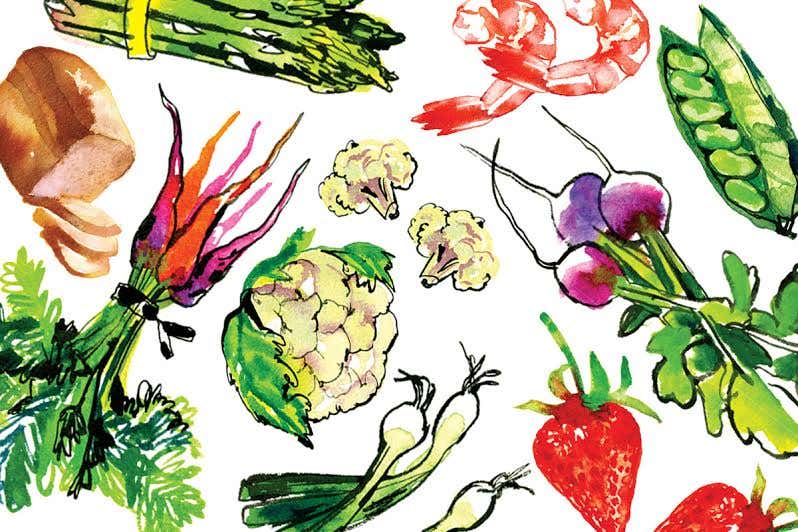
Family Secrets
Growing up in a Cantonese family in San Francisco, Grace Young ate her parents' delicious soups, steamed dishes, and stir-fries every day, and took them happily for granted. Only as an adult, with a career as a recipe developer and food stylist, did she realize that her family's classic dishes might be a vanishing treasure. Her parents were getting older, and most members of her extended family had forgotten the traditional specialties. Something beyond just good eating stood to be lost, too: a culinary philosophy based on the ancient harmonizing principles of yin and yang. So Young wrote The Wisdom of the Chinese Kitchen: Classic Family Recipes for Celebration and Healing to save her family's culinary heritage—and along the way, through the memories her relatives contributed to these pages, learned about her own history.
In Young's first section, Mama and Baba (she identifies her parents only through their affectionate nicknames), confident and resourceful, guide their daughter—and us—through a series of lessons in the arts of steaming, stir-frying, and braising. (Young, no novice in the kitchen, has plenty of her own expert advice to add, too.) In ''The Breath of a Wok'', one of the book's beautifully titled chapters, we learn about wok hay—literally, ''wok breath''—a fleeting taste, crucial to an authentic stir-fry, that only food right out of the wok can have. In ''Shreds of Ginger Like Blades of Grass'', Baba, despite his 84 years, smoothly slices ginger into feathery wisps that meld with the other flavors in a dish instead of dominating them. ''Cooking as a Meditation'' describes the ''true art of cooking by instinct'' that Mama and Baba practice. Nothing is timed or weighed. ''The most important virtue,'' her parents believe, ''is alertness to the senses; knowing when an ingredient has the correct visual cues, smells, sounds, tastes, and texture is more valuable than mastering the intricacies of a complicated recipe.'' For that reason, she admits, ''Trying to record a precise recipe by watching my parents cook is as difficult as catching an animal in the wild.'' In the end, though, she succeeds: The cookbook itself is her trophy collection.
Beyond the fundamentals, Young includes a section on symbolic feast foods and another on the healing soups that are a vital part of Cantonese home cooking. Both sections make fascinating reading, but frankly, it'll take me a while to work my way up to recipes like Buddha's delight, a New Year's dish that calls for 13 ingredients (among them dried oysters, cloud ears, and ginkgo nuts), or papaya and snow fungus soup, which requires a tricky-sounding double-steaming process. I've been happy cooking the simpler recipes. Pepper and salt shrimp are labor-intensive to prepare, but, when stir-fried, turn a brilliant, gratifying orange, with a crunchy edible shell and resilient sweet flesh. I also liked the juicy lemon chicken; Sichuan-style eggplant in garlic sauce; and braised sweet-and-sour spareribs, an easy recipe that yields complex flavor.
Given Young's emphasis on the yin-yang concepts in cooking—the balancing of opposites—it's surprising that she offers no menu suggestions. For a dinner party one night, I had to root through the whole book for clues on what to serve with what. The biggest headache, though, is the cruel absence of make-ahead instructions. Every single recipe is an unbroken continuum of cooking that ends with the words ''serve immediately''—which, if you're making a dinner party's worth of dishes, would seem to require two stoves and the cloning of the cook.
Young is firm about not giving substitutions. ''If you genuinely desire to cook Chinese dishes, you will need exotic ingredients,'' she writes. Most of the chapter ''Shopping Like a Sleuth'' is designed to guide you through a big-city Chinatown; if you aren't near one of these, you'll have to forego the pleasures of shopping and wait for UPS.
Regardless of your grocery situation, this is a book to be relished on several levels. It's rich in content, cleanly written, and beautifully designed, with black-and-gold typography and soft, flamelike shapes silk-screened onto the pages. The elegant old black-and-white family photos that introduce each chapter, as well as Alan Richardson's lush, painterly food photography, add to the delicate respectfulness of a book Young calls ''a modern-day act of filial piety''.
Keep Reading
Continue to Next Story










